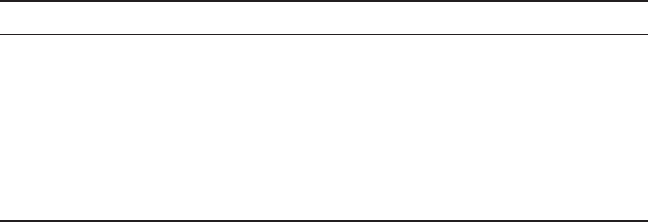Lin S.D. Water and Wastewater Calculations Manual
Подождите немного. Документ загружается.

Step 2. Calculate log inactivation for Giardia (X ) and viruses (Y )
X ⫽ 3(CT
cal
/CT
99.9
) ⫽ 3 ⫻ 0.45 log
⫽ 1.35 log
Y ⫽ 4 (CT
cal
/CT
99
.
9
) ⫽ 4 ⫻ 0.45 log
⫽ 1.8 log
Example 4: A water system pumps its raw water from a remote lake. No fil-
tration is required due to good water quality. Chlorine is dosed at the pump-
ing station near the lake. The peak pumping rate is 320 gpm (0.02 m
3
/s). The
distance from the pumps to the storage reservoir (tank) is 3300 ft (1000 m);
the transmission pipe is 10 in in diameter. The chlorine residual at the outlet
of the tank is 1.0 mg /L (C for the tank). The T
10
for the tank is 88 min at the
peak flow rate determined by a tracer study. Assuming the inactivation for
the service connection to the first customer is negligible, determine the min-
imum chlorine residue required at the inlet of the tank (C at the pipe) to meet
Giardia 3-log removal at 5°C and pH 7.0.
solution:
Step 1. Calculate CT
cal
for the pipe
Q ⫽ 320 gpm ⫽ 320 gal/min ⫻ 0.1337 ft
3
/gal
⫽ 42.8 ft
3
/min
T ⫽ r
2
L/Q ⫽ 3.14 (0.417 ft)
2
⫻ 3300 ft/(42.8 ft
3
/min)
⫽ 42 min
CT
cal
(pipe) ⫽ 42 C
p
(mg/L)min
where C
p
is chlorine residual at the end of the pipe.
Step 2. Calculate CT
cal
for the tank, CT
cal
(tank)
CT
cal
(tank) ⫽ 1.0 mg/L ⫻ 88 min ⫽ 88 (mg/L) min
Step 3. Find CT
99.9
for Giardia removal
At water temperature of 5°C, pH 7.0, and residual chlorine of 1.0 mg/L, from
Table 5.7:
CT
99.9
⫽ 149 (mg/L) min
Step 4. Calculate chlorine residue required at the end of the pipe (tank
inlet), C
p
CT
cal
(pipe) ⫹ CT
cal
(tank) ⫽ CT
99.9
From Steps 1 to 3, we obtain
42 min ⫻ C
p
(mg/L) ⫹ 88(mg/L)min ⫽ 149(mg/L)min
C
p
⫽ 1.45 mg/L (minimum required)
Public Water Supply 485

Example 5: In a 1-MGD water plant (1 MGD ⫽ 694 gpm ⫽ 0.0438 m
3
/s),
water is pumped from a lake and prechlorinated with chlorine dioxide at the
lake site. The source water is pretreated with chlorine at the intake near the
plant. The peak flow is 600 gpm. The worst conditions to be evaluated are at
5°C and pH 8.0. Gaseous chlorine is added at the plant after filtration (clear-
well inlet). The service connection to the first customer is located immediately
next to the clearwell outlet. The following conditions also are given:
Treatment unit Volume, gal Outlet residual Cl
2
, mg/L Baffling conditions
Rapid mixer 240 0.4 Baffled at inlet and outlet
Flocculators 18,000 0.3 Baffled at inlet and outlet
and with horizontal paddles
Clarifiers 150,000 0.2 Only baffled at outlet
Filters 6600 0.1
Clearwell 480,000 0.3 (free)
1.6 (combined)
Chlorine and ammonia are added at the clearwell inlet. Residual free and
combined chlorine measured at the outlet of the clearwell are 0.3 and 1.6
mg/L, respectively. Estimate the inactivation level of Giardia and viruses
at each treatment unit.
soution:
Step 1. Calculate CT
cal
for the rapid mixer
Assuming average baffling condition and using Table 5.6, we obtain the cor-
rection factor (T
10
/T) ⫽ 0.5 for average baffling.
Thus
ERT ⫽ HRT (T
10
/T ) ⫽ 0.4 min ⫻ 0.5
⫽ 0.2 min
Use this ERT as T for CT calculation
CT
cal
⫽ 0.4 mg/L ⫻ 0.2 min
⫽ 0.08 (mg/L) min
Step 2. Determine CT
cal
/CT
99
.
9
for the rapid mixer
Under the following conditions:
pH ⫽ 8.0
T ⫽ 5°C
5 0.4 min
HRT 5
V
Q
5
240 gal
600 gal/min
486 Chapter 5

residual chlorine ⫽ 0.4 mg/L
log inactivation ⫽ 3
From Table 5.7, we obtain:
CT
99.9
⫽ 198 (mg/L) min
CT
cal
/CT
99
.
9
⫽ (0.08 (mg/L) min)/(198 (mg/L) min)
⫽ 0.0004
Step 3. Calculate the log inactivation of Giardia for the rapid mixer
log removal ⫽ 3 (CT
cal
/CT
99.9
)
⫽ 0.0012
Step 4. Similar to Steps 1 to 3, determine log inactivation of Giardia for the
flocculators
with a superior baffling condition from Table 5.6, the correction T
10
/T ⫽ 0.7
ERT ⫽ HRT (T
10
/T) ⫽ 30 min ⫻ 0.7
⫽ 21 min
then
CT
cal
⫽ 0.3 mg/L ⫻ 21 min
⫽ 6.3 (mg/L) min
log removal ⫽ 3 [6.3 (mg/L) min]/[198 (mg/L) min]
⫽ 0.095
Step 5. Similarly, for the clarifiers
Baffling condition is considered as poor, thus
T
10
/T ⫽ 0.3
ERT ⫽ 250 min ⫻ 0.3 ⫽ 75 min
CT
cal
⫽ 0.2 mg/L ⫻ 75 min ⫽ 15 (mg/L) min
HRT 5
150,000 gal
600 gpm
5 250 min
5 30 min
HRT 5
V
Q
5
18,000 gal
600 gpm
Public Water Supply 487

log removal ⫽ 3 ⫻ 15/198
⫽ 0.227
Step 6. Determine Giardia removal in the filters
T
10
/T ⫽ 0.5
(Teefy and Singer, 1990. The volume of the filter
media is subtracted from the volume of filters with
good-to-superior baffling factors.)
ERT ⫽ 11 min ⫻ 0.5 ⫽ 5.5 min
CT
cal
⫽ 0.1 mg/L ⫻ 5.5 min
⫽ 0.55 (mg/L) min
log removal ⫽ 3 ⫻ 0.55/198
⫽ 0.008
Step 7. Determine Giardia removal in the clearwell
There are two types of disinfectant; therefore, similar calculations should be
performed for each disinfectant.
(a) Free chlorine inactivation.
In practice, the minimum volume available in the clearwell during the
peak demand period is approximately one-half of the working volume
(Illinois EPA, 1992). Thus, one-half of the clearwell volume (240,000 gal)
will be used to calculate the HRT:
HRT ⫽ 240,000 gal/600 gpm
⫽ 400 min
The clearwell is considered a poor baffling condition, because it has no inlet,
interior, or outlet baffling.
T
10
/T ⫽ 0.3 (Table 5.6), calculate ERT
ERT ⫽ HRT ⫻ 0.3 ⫽ 400 min ⫻ 0.3
⫽ 120 min
The level of inactivation associated with free chlorine is
CT
cal
⫽ 0.3 mg/L ⫻ 120 min
⫽ 36 (mg/L) min
From Table 5.7, CT
99.9
⫽ 198 (mg/L) min
HRT 5
6600 gal
600 gpm
5 11 min
488 Chapter 5

The log inactivation is
log removal ⫽ 3 ⫻ CT
cal
/CT
99.9
⫽ 3 ⫻ 36/198
⫽ 0.545
(b) Chloramines inactivation
CT
cal
⫽ 1.6 mg/L ⫻ 120 min
⫽ 192 (mg/L) min
For chloramines, at pH ⫽ 8, T ⫽ 5°C, and 3-log inactivation
CT
99.9
⫽ 2200 (mg/L) min (from Table 5.7)
Log inactivation associated with chloramines is
log removal ⫽ 3 ⫻ 192/2200
⫽ 0.262
The log removal at the clearwell is
log removal ⫽ 0.545 ⫹ 0.262
⫽ 0.807
Step 8. Summarize the log Giardia inactivation of each unit in the water
treatment plant
Unit Log inactivation
Rapid mixing 0.0012 (Step 3)
Flocculators 0.095 (Step 4)
Clarifiers 0.227 (Step 5)
Filters 0.008 (Step 6)
Clearwell 0.807 (Step 7)
Total 1.138
The sum of log removal is equal to 1.138, which is greater than 1. Therefore,
the water system meets the requirements of providing a 3-log inactivation of
Giardia cysts. The viruses inactivation is estimated as follows.
Step 9. Estimate viruses inactivation in the rapid mixer
Using CT
cal
obtained in Step 1
CT
cal
⫽ 0.08 (mg/L) min
Referring to Table 5.9 (T ⫽ 5°C, 4 log),
CT
99.99
⫽ 8 (mg/L) min
Public Water Supply 489
The level of viruses inaction in the rapid mixer is
log removal ⫽ 4 ⫻ CT
cal
/CT
99.99
⫽ 4 ⫻ 0.08/8
⫽ 0.04
Step 10. Estimate viruses inactivation in the fiocculators
CT
cal
⫽ 6.3 (mg/L) min (Step 4)
log removal ⫽ 4 ⫻ 6.3/8
⫽ 3.15
Step 11. Estimate viruses inactivation in the clarifiers
CT
cal
⫽ 15 (mg/L) min (Step 5)
log removal ⫽ 4 ⫻ 15/8
⫽ 7.5
Step 12. Estimate viruses inactivation in the filters
CT
cal
⫽ 0.55 (mg/L) min (Step 6)
log removal ⫽ 4 ⫻ 0.55/8
⫽ 0.275
Step 13. Estimate viruses inactivation in the clearwell
For free chlorine
CT
cal
⫽ 36 (mg/L) min (Step 6(a))
log removal ⫽ 4 ⫻ 36/8
⫽ 18
For chloramines
CT
cal
⫽ 192 (mg/L) min (Step 6(b))
CT
99.99
⫽ 1988 (mg/L) min (Table 5.9)
log removal ⫽ 4 ⫻ 192/1988
⫽ 0.39
Total log removal ⫽ 18 ⫹ 0.39 ⫽ 18.39
Step 14. Sum of log inactivation for viruses in the plant is
Plant log removal ⫽ sum of Steps 9 to 13
⫽ 0.04 ⫹ 3.15 ⫹ 7.5 ⫹ 0.275 ⫹ 18.39
⫽ 29.35
Note: Total viruses inactivation is well above 1.
The water system meets the viruses inactivation requirement.
490 Chapter 5
In summary, a brief description of regulations in the United States and
determination of CT values are presented. Under the SWTR, all surface
water supplies and groundwater supplies that are under the influence
of surface water must calculate CT values daily during peak hourly
flow. A minimum of 3-log Giardia lamblia and 4-log virus removal and/or
inactivation performance must be achieved at all times to comply with
the existing SWTR. The CT values are used to evaluate the achievement
of disinfection and to determine compliance with the SWTR. They also
are used to compute the log inactivation of Giardia and viruses during
water treatment and to construct a disinfection profile.
To calculate the CT value, operation data, e.g. disinfectant concen-
tration, water pH, and water temperature, should be measured daily
during the peak hourly flow. Contact time (T
10
), actual calculated CT
value (CT
cal
), 3-log Giardia inactivation (CT
99.9
from Table 5.7), and/or
4-log virus inactivation (from Table 5.9), CT
cal
/CT
99.9
, and CT
cal
/CT
99.99
should be calculated for the estimated segment log inactivations. The
total plant log inactivation is the sum of all segment log inactivations.
The daily log inactivation values can be used to develop a disinfection
profile for the treatment system.
18.5 Disinfection by-products
Water disinfection and its by-products. Chlorine has been widely used as
a disinfectant in water treatment process to kill or inactivate waterborne
pathogens. Chlorine disinfection of public drinking water had dramati-
cally reduced outbreaks of illness. In 1974, chloroform (trichloromethane)
was discovered as a disinfection by-product (DBP) resulting from the
interaction of chlorine with natural organic matter in water. This find-
ing raised a serious dilemma that water chlorination clearly reduced the
risk of infectious diseases and might also result in the formation of poten-
tially harmful DBP with this exposure in drinking water. DBP problem
is currently most concerned by water supply professionals.
Chlorine, chlorine dioxide, chloramines, ozone, and potassium per-
manganate are used in US water treatment plants as a disinfectant.
Table 5.11 lists some of the microorganisms targeted by disinfection
practice and some of more appropriate disinfectants for each microor-
ganism. Based on the types of disinfectants used, the numbers of water
supplies are roughly (keep changing) 22,000 (91.6%), 360 (1.5%), 140
(0.6%), 300 (1.3%), and 1200 (5.0%), respectively. The disinfectants are
often so powerful that they nonselectively react with other substances
in the water. There are actually thousands of DBPs. When natural
waters are disinfected, more than 100 potentially toxic halogenated
compounds can be created (Gray et al., 2001). The compounds of concern
are halogenated methanes, haloacetic acids, and nitrosamines.
Public Water Supply 491

Two classes of DBPs that dominate the identifiable organic matter;
trihalomethanes (THMs) and haloacetic acids (haloacetates, HAAs) are
of regulatory interest. THMs are a group of compounds with three halo-
gen atoms. Only chlorinated and brominated ones are routinely found
in potable water. Chloroform (CHCl
3
) is one of a class of compounds of
THMs. In the United States, since 1974, additional DBPs have been
identified in potable water and concerns have intensified about health
risks resulting from exposures to them. Along with chloroform, three
species that are of most concern are bromodichloromethane (CHBrCl
2
),
dibromochloromethane (CHBr
2
Cl), and tribromomethane (bromoform,
CHBr
3
). The above four species are called trihalomethanes. The sum of
these four species is expressed as total trihalomethanes (TTHMs). THMs
are regulated under the Stage 2 DBP rule (Table 5.11).
HAAs (Table 5.12) are also formed during chlorination of water. Like
THMs, HAAs are also linked with increased incidence of cancer in lab-
oratory animals (Herren-Freund et al., 1987; Xu et al., 1995). Unlike
THMs, HAAs are capable of dissociating in water. HAAs are >99% ion-
ized (deprotonated) to the haloacetate anions under drinking water con-
ditions. However, they are regulated and usually reported in terms of
the parent acids rather than the carboxylate anions (US EPA, 2001).
HAAs account for about 13% of the halogenated organic matter after dis-
infection (Weinberg, 1999).
Bromate is formed from the ozonation of source waters that contain
bromide. In ozonated water supplies, a variety of aldehydes and ketones
abound as well as some carboxylic acids. In addition to these organic
products, inorganic species are also found. These include oxyanions of
halogens, such as chlorite, chlorate, and bromate, which can be formed
by a variety of oxidizing disinfectants. Bromate is of particular interest
since it is suspected of posing one of the highest cancer risks of any DBP
(US EPA, 2001).
492 Chapter 5
TABLE 5.11 Effects of Disinfectants on Waterborne Pathogens
Bacteria, such as Giardia Cryptosporidium
coliform (E. coli), lamblia parvum
Disinfectants Legionella cysts oocysts Viruses
(Health effects) Legionnaire’s
disease, GI,* death GI, death GI, death GI, death
Chlorine X X X
Chlorine dioxide X X X X
Ozone X X X X
Chloramine X
*astroenteric disease

Due to concern about these DBPs for more than 3 decades, some DBPs
have been regulated and/or subjected to monitoring rules aimed to meet
the simultaneous goal of disinfecting water and controlling DBPs. Table
5.13 presents regulated compounds along with their important infor-
mation. It should be noted that only a very small subset of the much
larger list of substances have been identified as DBPs.
The Stage 2 DBP rule issued in January 2006, had (1) lowered the
TTHMs MCL 0.10 to 0.08 mg/L; (2) established an MCL of 0.06 mg/L
for five haloacetic acids (HAA5), including, monochloroacetic acid,
dichloroacetic acid, trichloroacetic acid, monobromoacetic acid, and dibro-
moacetic acid; (3) added an MCLG of 0.07 mg/L for (mono)chloroacetic
acid; (4) established an MCL of 0.010 mg/L for bromate; and (5) established
an MCL of 1.0 mg/L for chlorite.
Control of DBPs and pathogens. US EPA’s current drinking water research
program (in-house/contracted) is more sophisticated than it was in the
1980s. For example, when the treatment technology manual was pub-
lished in 1981, it reported primarily on treatment-oriented research.
Twenty-five years later, the technology research program includes source
water protection, treatment technology, and distribution system studies.
The research also reflects a concern over balancing the risks of potential
carcinogenic exposure against the risks from microbial infection.
Techniques for controlling DBPs and waterborne pathogens below have
mostly followed the US EPA (2001) report. The controlling techniques
include source protection, treatment process modification (enhanced
coagulation), alternative disinfectants, activated carbon, other granu-
lar filtration, membrane filtration process, control in drinking water
distribution system, etc.
Public Water Supply 493
TABLE 5.12 Haloacetic Acids Found in Potable Water
Haloacetic acids Chemical formula Grouping*
Chloroacetic acid ClCH
2
COOH HAA5, 6, 9
Dichloroacetic acid Cl
2
CHCOOH HAA5, 6, 9
Trichloroacetic acid Cl
3
CCOOH HAA5, 6, 9
Bromoacetic acid BrCH
2
COOH HAA5, 6, 9
Dibromoacetic acid Br
2
CHCOOH HAA5, 6, 9
Tribromoacetic acid Br
3
CCOOH HAA9
Bromochloroacetic acid BrClCHCOOH HAA6, 9
Bromodichloroacetic acid BrCl
2
CCOOH HAA9
Dibromochloroacetic acid BrClCCOOH HAA9
NOTES: *HAA5 is the sum of the concentrations of mono-, di-, and trichloroacetic acids and
mono- and dibromoacetic acids. HAA5 concentrations (as the sum) are regulated under the
Stage 2 DBP Rule. HAA6 data must be obtained and reported under the Information
Collection Rule (ICR). HAA9 data are encouraged to obtain and report under the ICR, but
not required.

494 Chapter 5
Compound
Total trihalomethanes
(TTHMs)
Chloroform
Bromodichloromethane
Bromoform
Dibromochloromethane
Haloacetic acids (HAA5)
(Mono)chloroacetic acid
Dichloroacetic acid
Trichloroacetic acid
Bromate
Chlorite
Residual disinfectant
Chlorine
Chloramines
Chlorine dioxide
MCLG,
mg/L
0.07
0
0
0.06
0.07
0
0.02
0
0.8
MRDLG,
mg/L
4.0
4.0
0.8
MCL,
mg/L
0.080
LRAA
0.060
LRAA
0.010
1.0
MRDL,
mg/L
4
4
0.8
By-products of
Chlorination
and
chloramination
Chlorination
and
chloramination
Chlorination
and
chloramination
Ozonation,
chlorination,
and
chloramination
Chlorination
and
chloramination
Chlorination,
and
chloramination
Chlorination
and
chloramination
Chlorination
and
chloramination
Chlorination
and
chloramination
Ozonation
Chlorine
dioxide
Potential health effect
Cancer and other
effects
Cancer, liver, kidney,
and reproductive
effects
Cancer, liver, kidney,
and reproductive
effects
Cancer, nervous
system, liver, and
kidney effects
Nervous system,
kidney, liver, and
reproductive effects
Cancer and other
effects
Cancer and other
effects
Cancer and other
effects
Possible cancer and
other effects
Cancer
Hemolytic anemia
TABLE 5.13 National Primary Drinking Water Regulations Regulated Levels for DBP
and Residual Disinfectants
NOTE: MCLG ⫽ maximum contaminant level goal, MCL ⫽ maximum contaminant level,
TTHMs ⫽ the sum of the concentrations of chloroform, bromodichloromethane,
dibromochloromethane, and bromoform, LRAA ⫽ a locational running
annual average,
HAA5 ⫽ the sum of the concentrations of mono-, di-, and trichloroacetic acids and
mono- and dibromoacetic acids,
MRDLG ⫽ maximum residual disinfectant level goal, MRDL ⫽ maximum residual
disinfectant level.
SOURCE: US EPS, 2001; www.epa.gov/OGWDW/regs.html, 2007
